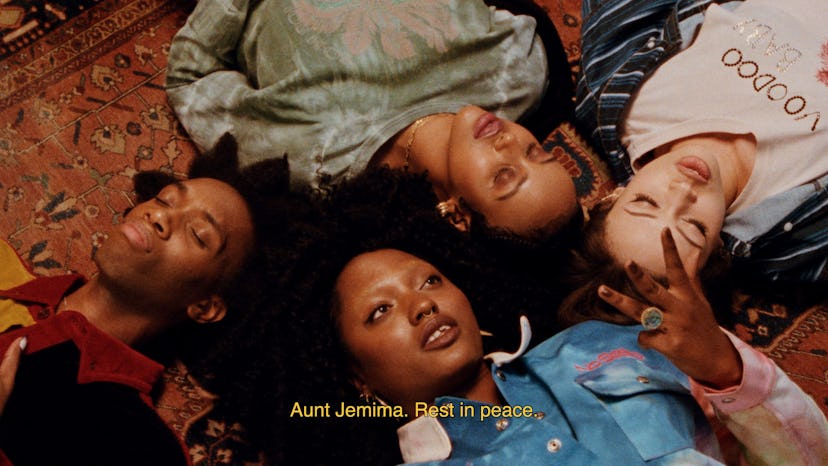Blacktag’s Short Film Black Art Is Black Money Gives Black Creators Their Due

Akin Adebowale and Ousman Sahko Sow, the founders of the creative platform Blacktag, experienced a uniquely full-circle moment while filming their short Black Art Is Black Money. The eight-minute film is the first official project to come from Blacktag, a resource that aims to connect Black alternative artists with larger companies, and launches this spring.
Last year, Adebowale and Sow were still in the trenches, pitching potential investors on the idea and assembling a crew who would star in the video, among them the dancer Jalaiah Harmon. Perhaps you are familiar with Harmon’s story: the 15-year-old created the choreography for one of TikTok’s most famous dances, the “Renegade.” Millions of people participated in the dance challenge before it came to light that the Black teenager from Fayetteville, Georgia had come up with the moves. “I think I could have gotten money for it, promos for it, I could have gotten famous off it, get noticed,” she told The New York Times months after it had become a phenomenon. “I don’t think any of that stuff has happened for me because no one knows I made the dance.”
Harmon’s lack of proper recognition inspired the foundation of Blacktag: Black people and Black culture are responsible for massive global trends in all cultural realms—music, food, fashion, art, literature, even Twitter—but are rarely given credit or compensation for it. This idea is also the subject matter of the film, which stars Parker Kit Hill, Sage Elsesser, Eloisa Santos, Gabrielle Richardson, Miski, and Harmon. In Black Art Is Black Money, the group surveys a fictional coffee table book titled White Book of Atrocities. As they turn each page, the creatives read aloud a laundry list of cultural contributions originated by Black people and largely co-opted by white men and women: Bantu knot hairstyles, techno and disco music, phrases like “lit,” and “on fleek,” and even the popularization of AirPods.
“I’m exhausted,” Richardson says in the film.
And indeed, exhaustion was one emotion Adebowale and Sow aimed to convey with Black Art Is Black Money.
“I wrote the film with a mindset of, ‘What’s the best way to send out this message, before we do anything?’” Adebowale said during a recent Zoom call with Sow. “What better way to do that than to recreate the conversation that we have all the time?”
Blacktag is launching at a moment that both Adebowale and Sow refer to as “the new Black Renaissance.” Resources, platforms, and businesses like Building Black Bed Stuy, the Black Fashion Fair, and the Black in Fashion Council are connecting Black artists and entrepreneurs in efforts to establish independent and, in turn, generational wealth.
“Our small part is turning creative power into economic power, but overall it’s contributing to this global charge of balancing the playing fields and making things right,” Adebowale added. “The new Black power is economic power.”
The platform is certainly on its way to becoming a legitimate powerhouse—Issa Rae is an investor, Common has partnered with Blacktag, and although they remained coy on the details, Adebowale and Sow said there are plenty more backers in the pipeline. For now, Blacktag will host both user-generated and original content created at Blacktag studios, and connect up-and-coming filmmakers and artists with independent production companies like A24.
“Issa Rae got onto YouTube and made Awkward Black Girl, and then HBO gave her a show,” Sow pointed out. “We can do that early. We could get to those creators before they go to YouTube, and provide a space for them, for their audiences that are already there.”
Black Art Is Black Money may be a piece of marketing for Blacktag, but its also educational and artistic—its tone and texture (and synth soundtrack) is not unlike a PSA from the 1980s. Harmon appears at the very end of the video, performing nearly 30 dance moves originated by Black creatives. Remember the full-circle moment? It happened while on set with Harmon, who approached Adebowale and Sow after filming her spot.
“She asked me, ‘Wait, Black people really created all these dances?’” Sow recalled. “You could tell in her face how fascinated and amazed, but also exhausted she was that none of these dances were recognized through those makers.”
“That speaks to the idea of something that empowers a creator through education,” Adebowale said. “You’re responsible for this and all your ancestors are responsible for this.”